Executive Summary
As we enter the final quarter of 2021, our valuation metrics for emerging external and local debt are moderately more attractive than they were at the beginning of the quarter:
- External debt valuations continue to remain within the historical range that we consider broadly neutral.
- Within local debt, emerging market (EM) currencies continue to remain at attractive levels having stayed through the quarter at the very top of the neutral range, while real interest rate differentials between EM and developed markets (DM) have continued to widen.
In this piece, we update our valuation charts and commentary, with additional detail on our methodology available upon request.1
External Debt Valuation
The EMBIG-D benchmark spread widened by 17 bps in Q3, ending the quarter at 357 bps. As seen in Exhibit 1, the fair market multiple is the benchmark’s credit spread to the spread that would be required to compensate for credit losses. This ratio rose marginally over the course of the quarter. The multiple stood at 2.5 on September 30, 2021, up from 2.4 on June 30, 2021. We estimate the credit multiple threshold range by analyzing the relationship between the subsequent two-year EMBIG-D credit spread returns and the credit multiple historically. A level that is higher than the upper range of the threshold (currently 2.8) has historically been associated with positive credit returns, while a level below the lower range of the threshold (currently 2.0) is associated more with negative credit returns over the next two-year period. This threshold range estimate is recalibrated on an annual basis. A level within this range would be considered neutral, which is where the market valuation falls at the end of the quarter.
Exhibit 1: Long-Term View of the "Fair Market Multiple" for Emerging External Debt
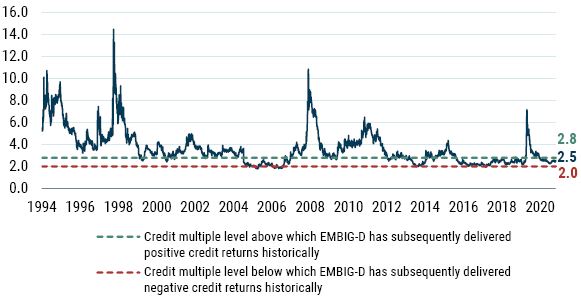
As of 9/30/2021 | Source: GMO calculations based on Bloomberg and J.P. Morgan data
Credit spread widening was the main reason for the small increase in the multiple over the quarter, as the multiple’s denominator – the fair value spread or expected credit loss – fell by only 1 bp to 142 bps at the end of September. Regular readers will recall that this fair value spread is a function of the weighted-average credit rating of the benchmark, along with historical sovereign credit transition data and an assumption about recovery values given default. In terms of the third quarter, the fair value spread was influenced by a couple of downgrades including Kuwait (AA- to A+ in July) and Ethiopia (B- to CCC+ in September). Additionally, while Panama, Sri Lanka, Peru, and El Salvador were placed on Negative Outlook, Jamaica was placed on Stable Outlook, and Oman was placed on Positive Outlook.
The preceding was a discussion of the level of spreads, or credit cushion. From a total return standpoint, the level and changes of the underlying risk-free rate also matters. In the third quarter, U.S. Treasury yields were basically unchanged, with the 10-year yield rising by 2 bps and having little impact on benchmark returns. We measure the “cushion” (which we proxy as the slope of the forward curve) in Treasuries by the slope of the forward curve of the 10-year swap rate, depicted by the light-font lines in Exhibit 2. As long-end U.S. Treasury yields were essentially unchanged during the quarter, the same was true for the slope of the 10-year forward curve; however, while the slope ended the quarter at 47 bps, the same level as the prior quarter, the entire curve shifted higher by about 15 bps, likely reflecting anticipation of a reduction in Fed bond purchases and impending rate hikes. This indicates the market is pricing in more of a cushion for rising rates, as the forward curve represents the path that would make an investor indifferent to holding treasuries and cash. We would view this as a positive relative to the previous quarter.
Exhibit 2: 10-Year U.S. Treasury Swap Curves at Quarterly Intervals
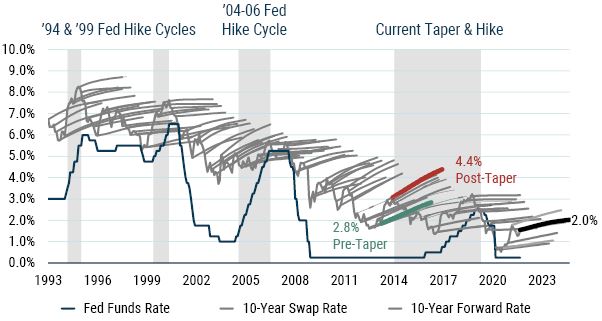
As of 9/30/2021 | Source: GMO
Local Debt Markets Valuation
Exhibit 3 provides a time series of our model’s estimate of the GBI-EMGD benchmark’s spot FX valuation. Recall that our model analyzes trends in macroeconomic fundamentals such as balance of payments composition and flows, valuation of the currency, and the economic cycle. It uses regression analysis to produce an estimate of total expected FX returns for each country in the benchmark. These are then combined into a single value of a total expected FX return using a market cap weighted average of currencies in the benchmark. Next, we deduct the weighted carry (interest-rate differential) from the estimated weighted value of total FX expected return to get to an expected EM FX spot return for GBI-EMGD. Finally, we estimate a neutral range based on the backtest of the overall model to assess whether EM currencies are cheap, rich, or fairly valued. A value that is higher (lower) than the upper (lower) value of the neutral range could potentially indicate “cheap” (“rich”) currencies. A value that is within the neutral range would be considered “fair.” EM currencies, though not outright cheap, ended September on the cheap end of the neutral range, while remaining attractive relative to the past 10-year average. We note that were one to adopt a more fundamentals based rather than behavioral and sentiment related model, EMFX would look very attractive. Our own decomposition of the model into these categories supports this view.
Exhibit 3: GBI-EMGD Expected Spot FX Return Given the Fundamentals
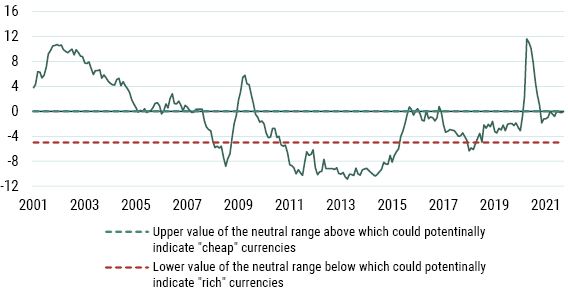
As of 9/30/2021 | Source: GMO
As a final comment on EM currency valuation, we also consider the current valuation of major DM currencies. This is useful to the extent that EM currencies as a complex often present a high beta trade opportunity vs. DM. While our process is focused on EM relative value by design, we do need to consider the overall valuation of major DM currencies to ensure that a secular move of major DM currencies against EM does not negatively affect EM relative value currency opportunities. In this regard when we consider a similar valuation model for EUR and CAD valuation, we find these to be currently in neutral territory. Neither currency is overvalued relative to historic norms, suggesting that a continued focus on EM currency relative valuation is reasonable given current valuations.
As for EM local interest rates, we consider differentials in real yields to gauge the relative attractiveness of EM against DM (see Exhibit 4, below). In this regard, the story that has been in place for many quarters (years, actually) remains as we can still see a substantial positive gap between EM and DM real yields. In fact, EM real yields look even more attractive on a relative basis against DM as that gap widened even further in Q3, when EM real yields rose by 33 bps to 2.33%. Specifically, the spread between EM and U.S. real yields widened by 66 bps during the quarter, to 418 bps, while the spread between EM and G3 widened by 52 bps to 374 bps. Having been fairly stable for several years running, the 5-year average of the spread between EM and U.S. real yields rose in Q3, from 227 bps to 234 bps. By our calculations, the real yield in the U.S. fell to -1.8% in September from -1.5% in June, while the European real yield and the Japanese real yield remain in negative territory.
Exhibit 4: Inflation-Adjusted Bond Yields
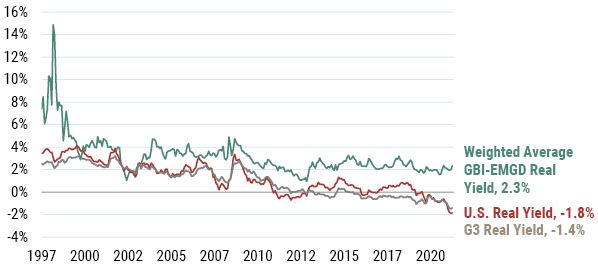
As of 9/30/2021 | Source: GMO
Liquidity – External and Local
One key feature of EM is low baseline and occasionally very poor liquidity. We consider this a feature of EM and GMO’s portfolios seek to manage this risk while extracting well compensated illiquidity premia as appropriate. We note that despite the significant volatility in spreads around the initial Covid-19 shock, overall bid-ask spreads have normalized and continue to indicate stable liquidity conditions (see Exhibit 5).
We correctly anticipated in the Q1 2020 version of this missive that the stabilization of bid-ask spreads following the impact of the pandemic and oil shocks would be quicker relative to prior crises. Both our external debt and local currency debt strategies emphasize instrument selection and tend to own securities with a lower liquidity profile than the benchmark. We are long-term oriented investors and liquidity providers in this type of market, and our process is able to identify dislocations and opportunities to pick up attractively priced securities. We believe this approach positions us well for alpha versus our benchmarks going forward.
Exhibit 5: EMBIG-D Bid-Ask Spread (% of price), Since December 1993
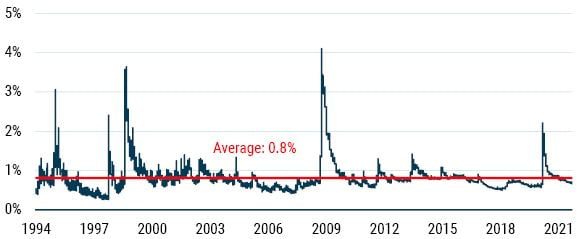
As of 9/30/2021 | Source: GMO
Download article here.

